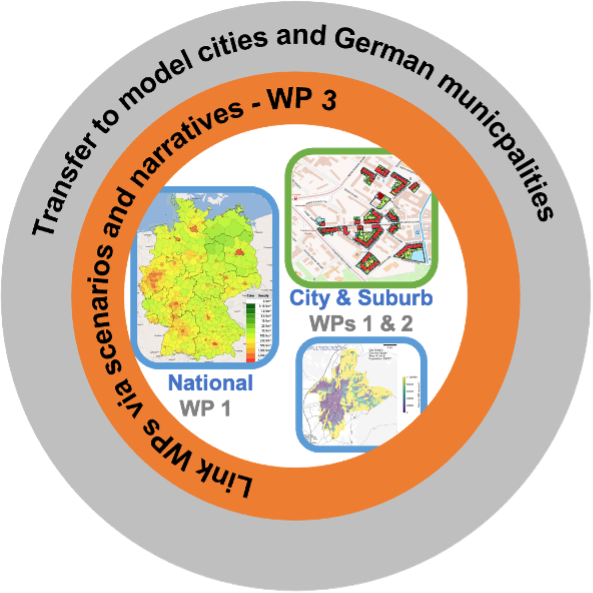Urban Transformations towards Blue-Green Infrastructures – UT-UBGI
The UT-UBGI project aims to drive tangible urban transformation by developing, planning and assessing blue-green infrastructure, leveraging an inter- and transdisciplinary approach that integrates both academia and practitioners. Our primary focus is on:
- Defining the scope and limitations of sustainable blue-green strategies at the city level.
- Quantifying the functions of blue-green infrastructure, such as urban cooling and biodiversity conservation and enhancement, and assessing their specific water requirements.
- Analyzing the urban narratives and potential conflicts and their solutions related to the implementation and effectiveness of urban blue-green infrastructure.
The innovation of our approach lies in three key aspects: (i) the interdisciplinary integration of disciplinary approaches and models through scenario-based planning, (ii) the partnership with German model cities to ground our research in real-world applications, and (iii) the synthesis of our findings to provide actionable insights for municipalities across Germany.
Project Goals
The project "Urban Transformations towards Blue-Green Infrastructures – UT-UBGI" is funded with 1.8 million € with a duration of three years (2024-2027).

The project aims to:
- Develop data-scalable UBGI scenarios and modeling approaches;
- Develop and apply techniques for the attribution of urban climate extremes to facilitate adaptation;
- Apply sustainable UBGI limits across Germany from medium-sized municipalities to data-rich cities;
- Integrate conflict analysis, negotiation strategies and narratives into UBGI scenarios and the broader context of UBGI transformation research.
The outcome will be modeling tools that support urban planning processes for German municipalities. Using scenario-based infrastructure planning, we will couple the consortia's expertise and specific modeling tools and methodological approaches. Climate mitigation and adaptation in urban spaces will remain a pressing issue in the coming years. The three Helmholtz Centers UFZ, KIT, and Hereon enable a strong and robust co-creation process towards a sustainable transformation of urban systems aiming to establish a joint Helmholtz research and innovation platform for urban systems.
Originality
As we move forward with the UT-UBGI project, we are focusing on several key areas of innovation and exploration to enhance urban resilience through green and blue infrastructure. These areas include:
- Scaling beyond suburbs (Leipziger BlauGrün, namares, Grüne Lunge, ProPolis) to whole cities and Germany.
- Moving towards data-reduced digital-twin solutions for smaller cities.
- Combining narratives with quantitative blue-green scenarios.
- How can we include conflicts and narratives in our quantitative infrastructure.
- Quantify the effect of cooling potential (PALM-4U) of specific blue green measures.
- Investigate trade-offs of city trees with specific focus on water demand and conflicting trade-off between biodiversity based on city trees as habitat and irrigation.

